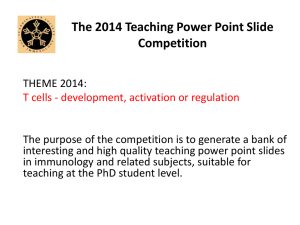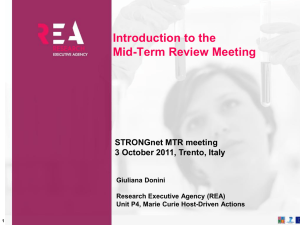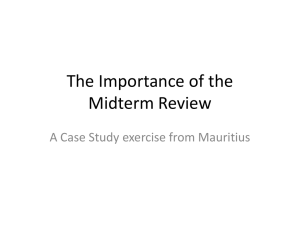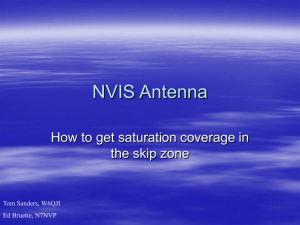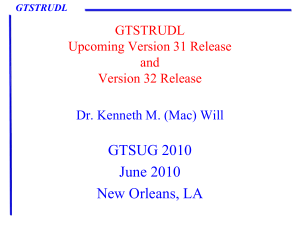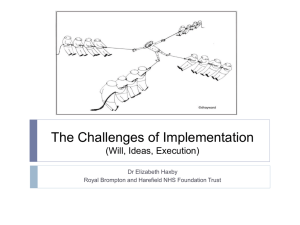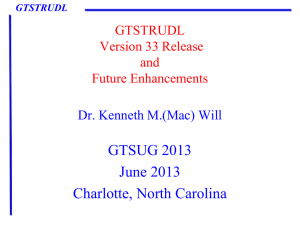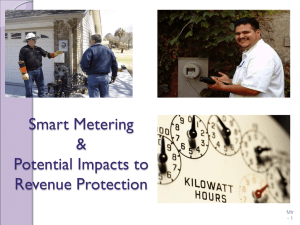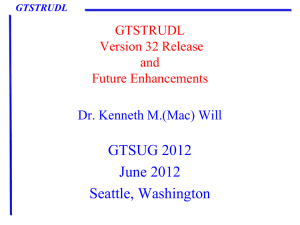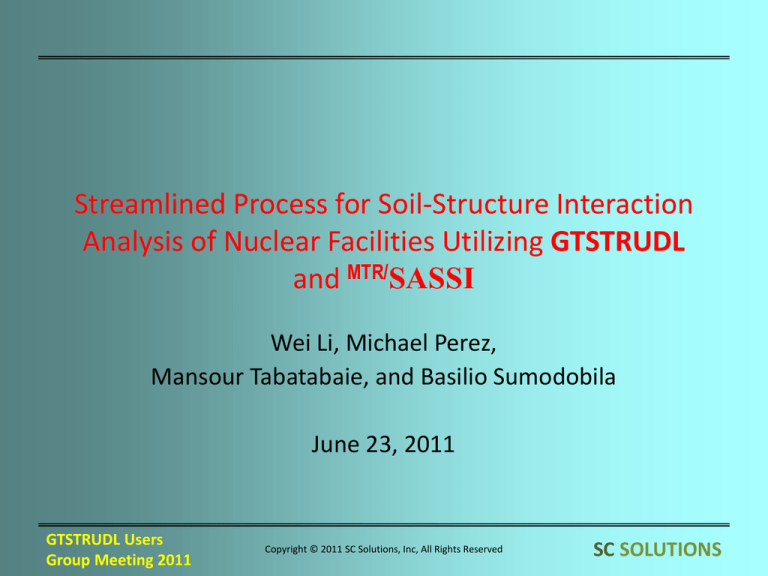
Streamlined Process for Soil-Structure Interaction
Analysis of Nuclear Facilities Utilizing GTSTRUDL
and MTR/SASSI
Wei Li, Michael Perez,
Mansour Tabatabaie, and Basilio Sumodobila
June 23, 2011
GTSTRUDL Users
Group Meeting 2011
Copyright © 2011 SC Solutions, Inc, All Rights Reserved
SC SOLUTIONS
Introduction
• Key advantages of this streamlined process
• Streamlined process for SSI:
–
–
–
–
–
Development of structural FE model in GTSTRUDL
Conversion of structural FE model from GTSTRUDL to MTR/SASSI
Verification of model conversion
Development of SSI model and SSI analysis using MTR/SASSI
Seamless transfer of SSI analysis results to GTSTRUDL for postprocessing/plotting
• Sample analysis results from two category I nuclear structures
GTSTRUDL Users
Group Meeting 2011
Copyright © 2011 SC Solutions, Inc, All Rights Reserved
SC SOLUTIONS
Key Advantages of this Streamlined Process
• GTSTRUDL and MTR/SASSI structural models are carbon copies
– Single structural FE model
• Stress analysis using GTSTRUDL
• SSI analysis using MTR/SASSI
– Same FE mesh, element numbering, node numbering, etc.
– Allows efficient model development and refinement and for seamless
transfer of pre- and post-processing data and results between the two
programs
– Simplifies transfer of results such as maximum nodal accelerations
between the two programs
• Large scale structural FE model
– Eliminates need for separate reduced model for SSI analysis
– Captures out-of-plane floor and wall dynamic responses
• Allows large scale SSI models with over 100,000 nodes to be efficiently
analyzed
• Simplifies QA process due to identical structural FE models
GTSTRUDL Users
Group Meeting 2011
Copyright © 2011 SC Solutions, Inc, All Rights Reserved
SC SOLUTIONS
GTSTRUDL - MTR/SASSI Streamlined Process
GTSTRUDL
Structural FE
MODEL
MTR/
SASSI
Perform fixed base
static and dynamic
analyses for
verification of model
conversion
Structural FE
MODEL
Develop & QA
GTSTRUDL structural
model
Convert model “as is” to
MTR/SASSI structural
model
Add excavated soil model &
soil layers to complete SSI
model
MTR/
SASSI
Structural FE
MODEL
MTR/
SASSI
EXCAVATED SOIL
FE MODEL
GTSTRUDL Users
Group Meeting 2011
MTR/
Perform SSI
analysis and
extract results
for plotting
using
GTSTRUDL
SASSI SOIL LAYERS
Copyright © 2011 SC Solutions, Inc, All Rights Reserved
SC SOLUTIONS
Development of FE model in GTSTRUDL
• Construct linear-elastic structural model
– Use elements available in MTR/SASSI (shells, solids, beams, etc.)
– Beam elements should be discretized into desired FE mesh
– Include added masses, applied loads, and load combinations
• Structural FE model should satisfy passing frequency requirements
for SSI analysis
• Perform fixed base static analysis
– Obtain dead load reactions to verify model geometry, material
densities, and added masses
– Obtain reactions for other load cases to verify applied loads
• Refine model as needed to capture target frequencies and design
iterations
GTSTRUDL Users
Group Meeting 2011
Copyright © 2011 SC Solutions, Inc, All Rights Reserved
SC SOLUTIONS
Model Conversion: GTSTRUDL to MTR/SASSI
• Export structural model from GTSTRUDL database
– Nodal coordinates
– Elements – shells, solids, plates, etc
• Element connectivity
• Material properties
• Element thickness for shell elements
– Members (Beam elements)
• Member connectivity
• Material and section properties
• Beta angles
– Springs
• Spring connectivity
• Spring stiffness and damping constants
– Other types of elements also available in MTR/SASSI
– Nodal masses for added masses
• Masses for elements/members included in structural FE model by MTR/SASSI
GTSTRUDL Users
Group Meeting 2011
Copyright © 2011 SC Solutions, Inc, All Rights Reserved
SC SOLUTIONS
Model Conversion: GTSTRUDL to MTR/SASSI
Export:
GTSTRUDL database
files (*.dbx): joints,
members, elements,
materials, etc
GTSTRUDL model
Import:
database files
(*.dbx) files to
Excel for
formatting into
MTR/SASSI syntax
GTSTRUDL Users
Group Meeting 2011
Export/
Combine
into
MTR/SASSI
HOUSE
input file
(_h.dat)
Copyright © 2011 SC Solutions, Inc, All Rights Reserved
MTR/
SASSI
Structural FE
MODEL
SC SOLUTIONS
Verification of Model Conversion
• Structural FE models
– GTSTRUDL model
– MTR/SASSI model
• Fixed-base static analysis results
– Compare reactions for all load cases considered
• Fixed-base dynamic analysis results
– Identify nodes of interest (base mat, walls, roof, etc)
– Extract acceleration time histories at selected nodes
– Compute and plot acceleration response spectra at selected nodes
GTSTRUDL Users
Group Meeting 2011
Copyright © 2011 SC Solutions, Inc, All Rights Reserved
SC SOLUTIONS
Comparison of Acceleration Response Spectra – Wall
• Wall normal to X-axis (out of plane response)
GTSTRUDL Users
Group Meeting 2011
Copyright © 2011 SC Solutions, Inc, All Rights Reserved
SC SOLUTIONS
Comparison of Acceleration Response Spectra – Wall
• Wall normal to Y-axis (out of plane response)
GTSTRUDL Users Group
Meeting 2011
Copyright © 2011 SC Solutions, Inc, All Rights Reserved
SC SOLUTIONS
Comparison of Acceleration Response Spectra – Intermediate Floor
• Floor slab normal to Z-axis (out of plane response)
GTSTRUDL Users
Group Meeting 2011
Copyright © 2011 SC Solutions, Inc, All Rights Reserved
SC SOLUTIONS
Comparison of Acceleration Response Spectra – Beam
GTSTRUDL Users
Group Meeting 2011
Copyright © 2011 SC Solutions, Inc, All Rights Reserved
SC SOLUTIONS
SSI analysis using MTR/SASSI
• Development of SSI model
– Add soil layers and properties
– Define interaction nodes
– Define excavated soil elements
• Perform time history SSI analysis and extract results
Add excavated soil model &
soil layers to complete SSI
model
MTR/
SASSI
Structural FE
MODEL
Interaction nodes
MTR/
SASSI
EXCAVATED SOIL
FE MODEL
GTSTRUDL Users
Group Meeting 2011
MTR/
Copyright © 2011 SC Solutions, Inc, All Rights Reserved
SASSI SOIL LAYERS
SC SOLUTIONS
Seamless Transfer of MTR/SASSI Analysis Results to GTSTRUDL
MTR/SASSI
SSI analysis results
1. Nodal forces and
moments
2. Nodal disps, velocities,
and accelerations
(results extracted at
each time step and
maximum results)
GTSTRUDL Users
Group Meeting 2011
GTSTRUDL
1. Results plotting
2. Additional postprocessing
3. Input for pseudo-static
stress analysis
(Can be read directly
by GTSTRUDL with
proper GTSTRUDL
commands since node
numbers and models
are identical)
Copyright © 2011 SC Solutions, Inc, All Rights Reserved
SC SOLUTIONS
Typical SSI analysis results
• Results plotting
– Maximum nodal acceleration and dynamic soil pressure contours
– In-structure time histories (ISTH) of accelerations, velocities,
displacements, and dynamic soil pressures
• Additional post-processing
–
–
–
–
In-structure response spectra (ISRS)
Sliding and overturning stability analysis results
Base shears and moments
Inter-story forces and moments
• Input for stress analysis
– Inertia forces from MTR/SASSI analysis can be imported to GTSTRUDL
for pseudo-static analysis to calculate member/element forces and
stresses for structural design
GTSTRUDL Users
Group Meeting 2011
Copyright © 2011 SC Solutions, Inc, All Rights Reserved
SC SOLUTIONS
Streamlined procedure used to evaluate two category I nuclear
structures
• Seismic SSI analysis of 2 category I structures in a nuclear power
plant currently undergoing certification
• Linear-elastic structural FE models constructed using:
– PLATE elements and SPACE FRAME members in GTSTRUDL
– PLATE/SHELL and 3D BEAM elements in MTR/SASSI
• Live and dead loads including equipment weight
• Added hydrodynamic masses
• SSI analysis performed for combination of ground motions and soil
conditions
GTSTRUDL Users
Group Meeting 2011
Copyright © 2011 SC Solutions, Inc, All Rights Reserved
SC SOLUTIONS
Example 1
• Near surface category I nuclear structure with shear keys
MTR/SASSI Excavated
Soil Model
GTSTRUDL/MTR/SASSI Structural Model
Structural model: 14420 nodes
SSI model: 17887 nodes
GTSTRUDL/MTR/SASSI shear Key Model
GTSTRUDL Users
Group Meeting 2011
Copyright © 2011 SC Solutions, Inc, All Rights Reserved
SC SOLUTIONS
Example 2
• Deeply-embedded category I nuclear structure
GTSTRUDL/ MTR/SASSI Structural Model
GTSTRUDL/ MTR/SASSI Longitudinal Cut View
Structural model: 15275 nodes
SSI model: 32133 nodes
MTR/SASSI Excavated
GTSTRUDL Users
Group Meeting 2011
Soil Model
Copyright © 2011 SC Solutions, Inc, All Rights Reserved
SC SOLUTIONS
Maximum Accelerations
• Table of maximum accelerations at key locations
• Near surface structure
Building Location
Elevation (ft)
Node No.
Basemat SW Corner
Basemat NE Corner
Basemat Center
-6.00
Basemat Equipment
˝
Fan Room at Elevation
of 51.5 feet
+50.50
1001
1501
5757
1172
1395
3056
3396
3380
3040
GTSTRUDL Users
Group Meeting 2011
˝
˝
Maximum Absolute Accelerations
X-Dir.
Y-Dir.
Z-Dir.
0.422
0.376
0.464
0.409
0.367
0.481
0.421
0.370
0.489
0.421
0.375
0.472
0.415
0.379
0.436
0.574
0.507
0.567
0.579
0.486
0.464
0.604
0.476
0.504
0.586
0.498
0.480
Copyright © 2011 SC Solutions, Inc, All Rights Reserved
SC SOLUTIONS
Plot of Maximum Accelerations (X-direction)
Near surface
structure
GTSTRUDL Users
Group Meeting 2011
Copyright © 2011 SC Solutions, Inc, All Rights Reserved
SC SOLUTIONS
Plot of Maximum Accelerations (Y-direction)
Deeply-embedded
structure
GTSTRUDL Users
Group Meeting 2011
Copyright © 2011 SC Solutions, Inc, All Rights Reserved
SC SOLUTIONS
Plot of Maximum Accelerations (Z-direction)
Deeply-embedded
structure
GTSTRUDL Users
Group Meeting 2011
Copyright © 2011 SC Solutions, Inc, All Rights Reserved
SC SOLUTIONS
In-Structure Spectral Acceleration Response: Base-mat
2.0
In-Structure
In-Structure
Reference Outcrop Motion
Reference Outcrop Motion
Y-Spectral Acceleration (g's)
X-Spectral Acceleration (g's)
2.0
1.5
1.0
Damping = 5%
0.5
1.5
1.0
Damping = 5%
0.5
0.0
0.0
0.1
1
10
100
0.1
1
Frequency (Hz)
10
100
Frequency (Hz)
2.0
In-Structure
Z-Spectral Acceleration (g's)
Reference Outcrop Motion
1.5
• Near surface structure
• Envelope accelerations
1.0
Damping = 5%
0.5
0.0
0.1
1
10
100
Frequency (Hz)
GTSTRUDL Users
Group Meeting 2011
Copyright © 2011 SC Solutions, Inc, All Rights Reserved
SC SOLUTIONS
In-Structure Spectral Acceleration Response: Wall Platform Supports
4.0
In-Structure
In-Structure
Reference Outcrop Motion
Reference Outcrop Motion
Y-Spectral Acceleration (g's)
X-Spectral Acceleration (g's)
4.0
3.0
2.0
Damping = 5%
1.0
3.0
2.0
Damping = 5%
1.0
0.0
0.0
0.1
1
10
100
0.1
1
Frequency (Hz)
10
100
Frequency (Hz)
2.5
Z-Spectral Acceleration (g's)
In-Structure
Reference Outcrop Motion
2.0
1.5
1.0
• Deeply-embedded structure
• Envelope accelerations
Damping = 5%
0.5
0.0
0.1
1
10
100
Frequency (Hz)
GTSTRUDL Users
Group Meeting 2011
Copyright © 2011 SC Solutions, Inc, All Rights Reserved
SC SOLUTIONS
Maximum Absolute Total Inter-story
Dynamic X-Shear Force and YY-Overturning Moment Diagram
My
80
80
70
70
60
60
50
50
40
40
Elevation (ft)
Elevation (ft)
Vx
30
30
20
20
10
10
0
0
-10
-10
-20
-20
0
10,000
20,000
GTSTRUDL Users
Group Meeting 2011
0
500,000
1,000,000
My (K-ft)
Vx (Kips)
Total
30,000
Net
Total
Copyright © 2011 SC Solutions, Inc, All Rights Reserved
Net
1,500,000
Near surface
structure
SC SOLUTIONS
Maximum Absolute Total Inter-story
Dynamic Y-Shear Force and XX-Overturning Moment Diagram
Mx
80
80
70
70
60
60
50
50
40
40
Elevation (ft)
Elevation (ft)
Vy
30
30
20
20
10
10
0
0
-10
-10
-20
-20
0
5,000
10,000
15,000
GTSTRUDL Users
Group Meeting 2011
0
200,000
400,000
600,000
Mx (K-ft)
Vy (Kips)
Total
20,000
Net
Total
Copyright © 2011 SC Solutions, Inc, All Rights Reserved
Net
800,000
Near surface
structure
SC SOLUTIONS
Sliding Stability Analysis
• Near surface structure
• D/C ratios and Factors of Safety
• Maximum values
• Values at each time step
• Computes min base friction
coefficient to meet F.S. = 1.1
GTSTRUDL Users
Group Meeting 2011
Copyright © 2011 SC Solutions, Inc, All Rights Reserved
SC SOLUTIONS
Overturning Stability Analysis
• Deeply-embedded structure
• D/C ratios and Factors of Safety
• Maximum values
• Values at each time step
GTSTRUDL Users
Group Meeting 2011
Copyright © 2011 SC Solutions, Inc, All Rights Reserved
SC SOLUTIONS
Summary
• GTSTRUDL and MTR/SASSI structural models are carbon copies
– Single structural FE model
• Stress analysis using GTSTRUDL
• SSI analysis using MTR/SASSI
– Same FE mesh, element numbering, node numbering, etc.
– Allows efficient model development and refinement and for seamless
transfer of pre- and post-processing data and results between the two
programs
– Simplifies transfer of results such as maximum nodal accelerations
between the two programs
• Large scale structural FE model
– Eliminates need for separate reduced model for SSI analysis
– Captures out-of-plane floor and wall dynamic responses
• Allows large scale SSI models with over 100,000 nodes to be efficiently
analyzed
• Simplifies QA process due to identical structural FE models
GTSTRUDL Users
Group Meeting 2011
Copyright © 2011 SC Solutions, Inc, All Rights Reserved
SC SOLUTIONS
Questions?
GTSTRUDL Users
Group Meeting 2011
Copyright © 2011 SC Solutions, Inc, All Rights Reserved
SC SOLUTIONS

